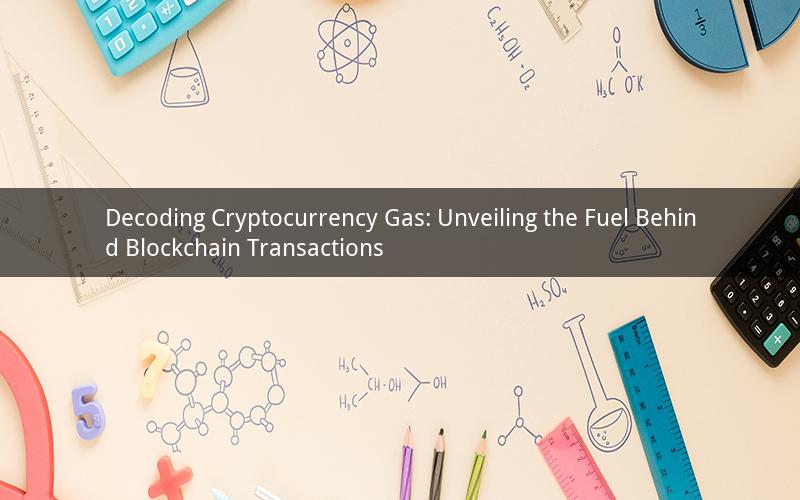
Introduction:
Cryptocurrency gas refers to the computational work required to execute transactions on blockchain networks. It serves as the fuel that powers the decentralized ecosystems, ensuring smooth and efficient transaction processing. In this article, we will delve into the intricacies of cryptocurrency gas, its purpose, and its significance in the world of blockchain technology.
What is Cryptocurrency Gas?
1. Definition:
Cryptocurrency gas is the unit of measurement used to quantify the computational resources needed to execute a transaction on a blockchain network. It represents the cost of using the network's resources, such as processing power and storage.
2. Origin:
The concept of cryptocurrency gas was introduced by Ethereum, one of the first blockchain platforms to adopt the concept. It serves as a mechanism to regulate the usage of the network, ensuring that no single user or entity can monopolize the computational resources.
3. Importance:
The existence of cryptocurrency gas is crucial for several reasons:
a. Scalability: Cryptocurrency gas helps in maintaining the scalability of blockchain networks. By requiring users to pay for transactions, the network can prioritize higher-value transactions over spam or low-value ones.
b. Incentivization: Gas fees incentivize miners or validators to process transactions. This creates a competitive environment, encouraging them to prioritize transactions with higher fees.
c. Security: The presence of gas fees acts as a deterrent for malicious actors attempting to exploit the network. It discourages them from flooding the network with spam or low-value transactions.
Understanding the Gas Limit
1. Definition:
The gas limit is the maximum amount of gas that can be consumed during a single transaction. It represents the maximum computational work that the network will allow for a transaction to be executed.
2. Purpose:
The gas limit is essential for ensuring the security and stability of the network. By setting a maximum limit, the network can prevent certain attacks, such as the infinite loop attack, where a transaction could potentially consume an excessive amount of resources.
3. Factors Affecting the Gas Limit:
a. Transaction Complexity: The more complex a transaction is, the higher the gas limit required to execute it.
b. Network Congestion: During times of high network congestion, the gas limit may increase to accommodate the higher demand for computational resources.
Calculating Gas Fees
1. Definition:
Gas fees are the payments made by users to cover the cost of using the network's resources. They are denominated in the cryptocurrency of the respective blockchain network.
2. Factors Influencing Gas Fees:
a. Network Congestion: Higher gas fees are often associated with higher network congestion. As more users compete for limited resources, the price of gas fees tends to increase.
b. Transaction Complexity: Complex transactions require more computational resources, leading to higher gas fees.
c. Block Size: The size of a block influences the number of transactions it can accommodate. A smaller block size may result in higher gas fees due to increased competition for space.
Optimizing Gas Fees
1. Definition:
Optimizing gas fees refers to the process of finding the most cost-effective gas fee for a given transaction. This involves analyzing factors such as network congestion, transaction complexity, and historical gas fees.
2. Strategies for Optimizing Gas Fees:
a. Using Gas Price Tracking Tools: Monitoring historical gas fees and utilizing gas price tracking tools can help users estimate the optimal gas fee for their transactions.
b. Waiting for Off-Peak Hours: Executing transactions during off-peak hours can help reduce gas fees, as there is less competition for network resources.
c. Simplifying Transactions: Reducing the complexity of transactions can help lower gas fees.
Frequently Asked Questions (FAQs)
1. Q: What is the difference between gas and gas fee?
A: Gas represents the computational work required to execute a transaction, while gas fee is the payment made by users to cover the cost of using the network's resources.
2. Q: How do gas fees affect the blockchain network?
A: Gas fees incentivize miners or validators to process transactions, ensuring the smooth functioning of the network. They also act as a deterrent for malicious actors, preventing network congestion.
3. Q: Can I reduce my gas fees?
A: Yes, you can optimize your gas fees by monitoring historical gas prices, waiting for off-peak hours, and simplifying your transactions.
4. Q: How does network congestion affect gas fees?
A: During periods of high network congestion, gas fees tend to increase as more users compete for limited computational resources.
5. Q: Can gas fees be converted into a fiat currency?
A: No, gas fees are denominated in the cryptocurrency of the respective blockchain network and cannot be converted into fiat currency.
Conclusion:
Cryptocurrency gas plays a crucial role in the functioning of blockchain networks. Understanding its purpose, how it is calculated, and the factors influencing gas fees can help users make informed decisions when transacting on the blockchain. By optimizing gas fees, users can ensure efficient and cost-effective transactions while contributing to the overall stability and security of the network.